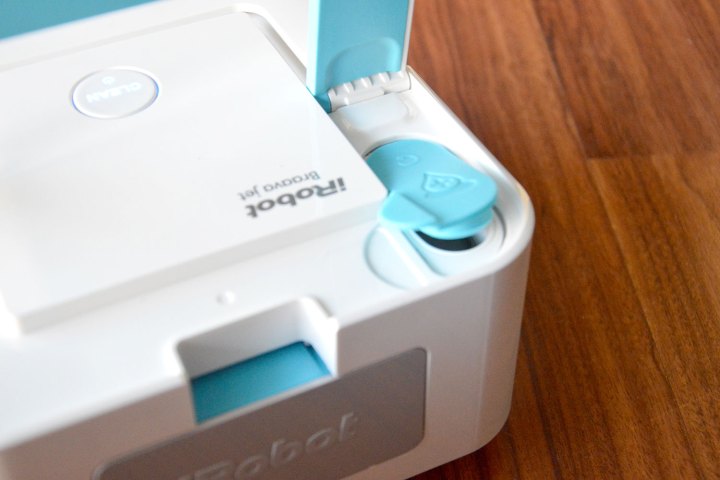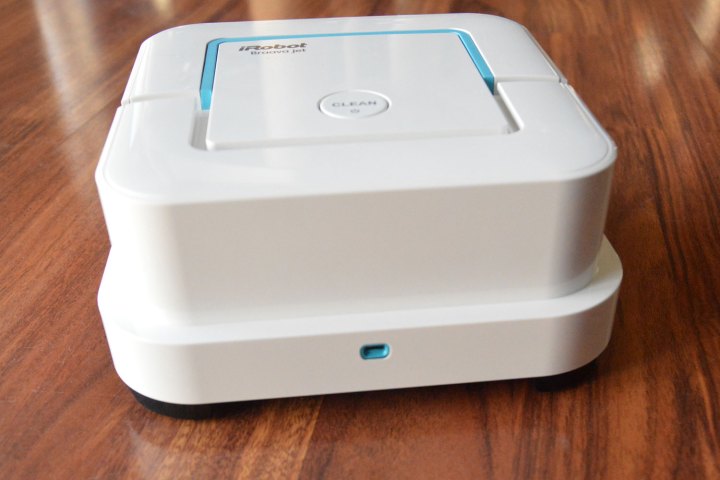When we first pulled the iRobot Braava Jet 240 box out of the shipping box, we thought there’d been a mistake. It was so little! But that’s because the robot itself is a 6.7-by-7-inch little square that’s just over three inches tall. The rest of the box was accessories: a battery, a charger, and two each of the different types of mops (wet, damp, and dry).
Start and stop
The Braava is white and blue, with a round “clean” button top that starts and stops it. Tap it once to wake it, then again to get it cleaning. There’s a lid that doubles as a handle. When open, it reveals a button to release the cleaning pad and a stopper for the water tank. The stopper lifts and twists out of the way, so you can fill the tank with warm water. There’s also a removable filter covering the tank.
Underneath, the Braava Jet has two wheels. A good portion of the bottom gets covered by the cleaning pads, which slide in between two plastic holders. On the back is the battery compartment; the front holds a nozzle for spraying water.
Because of its small size, the Braava Jet 240 gets into nooks and crannies.
Unlike traditional robot vacuums, this mopping bot doesn’t have a dock. Instead, the battery is removable and fits into an outlet charger. This means you can’t schedule the Braava, because it can’t charge itself. On the flip side, this robot will likely tuck away under your kitchen sink, so you don’t have to devote a whole corner of the room to it as you do with robo-vac and its dock.
The mop-bot has three modes, and it automatically knows how to behave based on the type of cleaning pad. On the back of each pad is a kind of old-school punch card for the Braava to detect. If you’re using the white dry cloth, you don’t need to fill it with water, and it can clean up to 250 square feet. Put on the orange damp cloth, add some water, and the Jet can tackle the same-sized room, doing a double pass over each area. The blue wet mop pad is for well-sealed floors, as it uses more water than the damp mode. For wet mopping, the device makes the rounds three times, so it can only cover 200 square feet.
Water drop
Because each floor is different, iRobot doesn’t give a specific time for how long the battery will last, but we used the Braava in wet mop mode for over an hour (on a two-hour charge) to clean our kitchen and dining room floors. Not all cycles take this long; the mop cleaned our bathroom in about 15 minutes. Because of its small size, the Braava is really good at getting into nooks and crannies. Unlike a vacuum bot, it rides right along walls — you can actually hear it brush against them as it moves. The Jet had no trouble fitting under either our bathroom or kitchen cupboards. For that reason, it pushed around some debris our robot vac had missed on an earlier sweep. (Yes, you have to vacuum pre-bot-mopping.)

In each mode, the Braava is pretty quiet. It makes whirring sounds when it’s “thinking” or spraying water. It can also be a bit clumsy, bumping into things (including our foot and the cat). Since you don’t want this sucker on your carpet, you can set up a single virtual wall by pressing the clean button, then holding it down for five to 10 seconds. You’ll want to position the robot so the wall will be in line with its back.
iRobot makes reusable cleaning pads for its mopping robot.
The Braava Jet 240 does have an app, but it’s not super robust. The most useful feature is the “spot clean” button, which makes several passes over a 4-foot-by-4-foot square for targeted mopping. The app lets you adjust the water level the nozzle spritzes out. You can also check the battery life, create a virtual wall, and start the mop from your phone.
After using the three types of pads, we were impressed by the job the Braava did. It’s very thorough, mapping its route and returning to every corner. We were on the verge of rescuing it a couple of times when it was making a vibrating noise, seemingly stuck between some chair legs, but it managed to work its way out on its own. Sometimes it pays to be puny.
All the slop
There were a few things the Braava left behind, both caused by cats. There were some residual pieces of catnip the vacuum didn’t suction up that the mop pushed into a pile along the counter. Also, there were a few mystery stains near the water and food bowls the 240 couldn’t take care of, so we had to bust out the cleaning spray and paper towel. But every time we flipped over the Braava and looked at the cleaning pad, we were pretty grossed out by how much fur and filth were on our floors. It also made us wonder if we should be rinsing that sucker halfway through.

While iRobot wants you to use its one-and-done disposable pads ($8 for a 10-pack), they do make reusable versions of the wet mop variety ($20 for two). You can use and wash those 50 times before having to toss them, which is probably better for both your wallet and the landfills.
There’s a larger version of the Braava, the 380t, which covers 1,000 square feet when dusting and 350 square feet when mopping. Its bulkier size means it might not wriggle into — and out of — as many tight spaces as the 240. While the smaller bot can’t traverse as far, it should do just fine for non-palatial kitchens and bathrooms.
The Braava Jet 240 may not get your floors as pristine as a mop, bucket, and manual labor, but it definitely beats letting grime accumulate for weeks at a time. Lazy about mopping? It’s not a bad investment.





